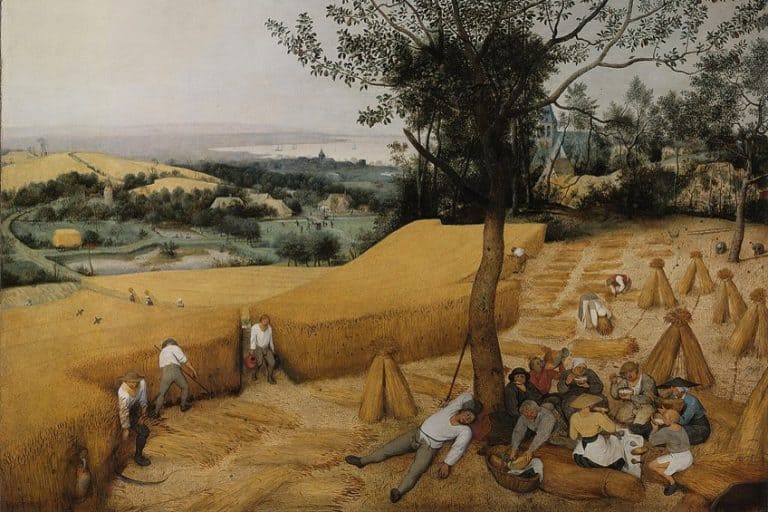Prehistoric Art – History of Humanity’s Earliest Artforms
There was a time that humans had not yet developed any kind of written language. During this period, various art forms served as a practical method for imparting information between themselves and other tribes. Prehistoric art refers to prehistoric artifacts and art created in the Stone Age, Paleolithic and Neolithic periods.
Table of Contents
The Definition of Prehistoric Art
Prehistoric art could be defined as art that was created by people in an era where any form of written language had yet not been developed. The time in which various cultures throughout human history started developing their unique language systems varies greatly from region to region.
Before leaving historians a written record of daily events, prehistoric artists left a treasure trove of information behind through their prehistoric artifacts and prehistoric drawings.
Prehistoric artists recorded their daily experiences in mediums that have managed to make it through centuries of harsh exposure to changing environmental conditions, giving us detailed insights into what life was like in the earliest days of our species before the development of a written form of communication.

The Origins of Prehistoric Art
Around 500 000 years ago, one of our early ancestors took a shark’s tooth and engraved a zig-zag pattern on the surface of a seashell. Although the reason for its creation is unknown, it is considered to be the earliest existing example of art. As paleolithic art transitioned to neolithic art from the old stone age, we see the use of charcoal, a medium that has continued to artworks created by modern humans. Let’s look at the various periods during which art first began to emerge in prehistoric art history.
Lower and Middle Paleolithic Era
The engraved shell was said to come from the later years of the Lower Paleolithic, but most of the evidence points to the Middle Paleolithic as having the best examples of the use of art for expressive reasons instead of being purely practical in application, like elaborately carved stone tools.
Early hand axes like those found at a site by archeologists at Saint Acheul in France have been shown to contain a degree of symmetry and styling that could be evidence of creative expression.
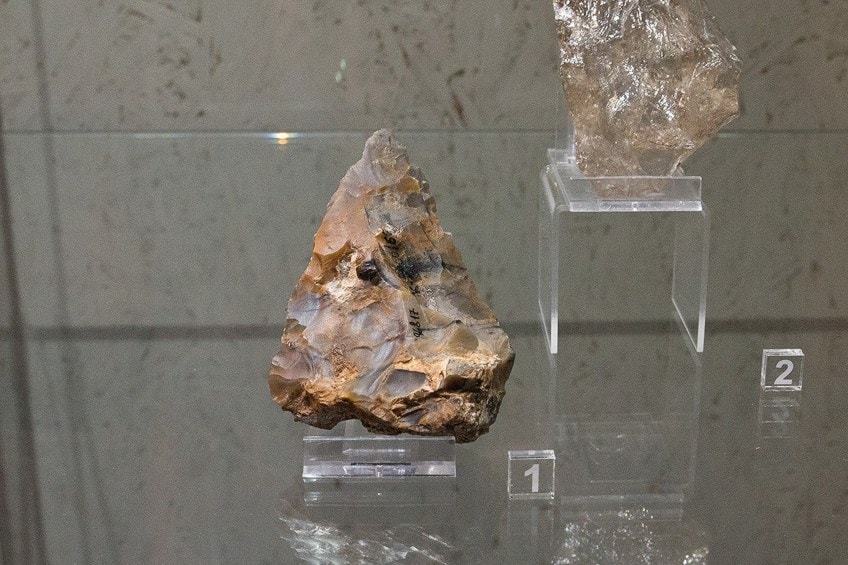
Other potential candidates for the earliest examples can be found in the Blombos Cave in South Africa and the Venus of Tan-Tan in Morocco. The patterns found on the walls of the Blombos caves are dated to around 73, 000 years old and are thought to possibly be the earliest existing examples of art made by the human hand.
Upper Paleolithic
In a cave on the island of Borneo in 2018, scientists discovered what is thought to be the oldest known painting depicting the human form. It has been dated to somewhere between 40, 000 and 52, 000 years of age.
Some of the earliest uncontested examples of figurative prehistoric artifacts were found in Baden-Württemberg, Germany.
These also date to around 40, 000 years ago, the Venus of Hohle Fels being a well-known example of prehistoric art history from this period. Cave paintings from around 40, 000 to 10, 000 years ago are another source of Upper Paleolithic art depicting figurative forms and motifs, as well as the sculpture The Venus of Willendorf and several animal carvings, like the Wolverine pendant of Les Eyzies, which depicts a wolf engraved onto a bone.

Prehistoric Art Around the World
Various cultures around the world developed written languages at different times in human history, so each region has a unique story regarding its initial development of art. Let’s take a look at how prehistoric artworks first emerged in various regions across the globe, from Spain to Australia and everywhere in between.
Asian Prehistoric Art
The prehistoric art history of Asia is specifically unique because the written language was adopted early on the continent, especially in China. Mesopotamian art is rarely defined as prehistoric, as written language took roots relatively early in the region, but the surrounding cultures such as the Persian, the Urartu, and Luristan cultures have all had impactful and highly detailed art traditions.
In Azerbaijan, dated to be around 12, 000 years old, there are approximately 6000 or more rock engravings that represent the figures of humans and animals engaged in various hunting scenarios, which are located at the National Park in Gobustan.

There are also objects that look similar in design to the Viking Longships. The earliest examples of paintings on the Indian sub-continent are petroglyphs such as those found at the Rock Shelters of Bhimbetka. Petroglyphs are images that are created when a surface such as a cave wall is scraped or picked at until an image is revealed.
In China’s Bronze Age, the Shang and Zhou Dynasties created many prehistoric artifacts such as bronze objects for ritualistic purposes.
Whereas in Japan, the first people to develop pottery were the ancient Jōmon people, dating to around the 11th millennium BC. The Jōmon used sticks or cords (sometimes braided) to create patterns on the wetted clay figures. In Korea, the first examples of art date from somewhere in 3000 BCE, consisting mostly of sculptures as well as petroglyphs according to more recent archeological discoveries.
The Near East Prehistoric Art
The world’s oldest megaliths can be found at the archeological site of Göbekli Tepe in Turkey. On pillars made during the Pre-Pottery Neolithic phase, one can find reliefs portraying human and animal figures as well as abstract patterns. Around the same time in 9000 BCE in Israel, the first known artwork representing two human figures engaged in intercourse, the Ain Sakhri, was said to have been made in Bethlehem.

It is the rise of the Achaemenid Empire that is seen as being the end of the prehistoric era in the Near East in the 6th century, however, writing had already existed for two thousand years by then. Yet this entire period is considered prehistoric despite some of the works having text such as the name of rulers displayed on them.
European Prehistoric Art
During the Stone Age, it was common for humans to carve animal figures onto objects such as bone or antlers, as well as the walls of caves. This was also the period of the Venus figurines. In certain places, simplistic pottery objects also began being created around this time. This age is divided into the Mesolithic and the Neolithic Age. The Mesolithic Period came after the Upper Paleolithic and before the Neolithic Age. In comparison to the other periods, there is little art that has survived from this period.
The art of the Iberian Mediterranean Basin, for example, is far less known when compared to similar sites from the Upper Paleolithic Period.
At sites such as Roca dels Moros, the art is mostly found on cliff faces exposed to the open-air environment. Containing the image of 45 figures, the subject seems to be mainly focused on the human form rather than animal figures. Figures can also be seen to be wearing noticeable garments of clothing and depict daily scenes like food gathering, hunting, engaged in a battle against feuding tribes, and dancing.
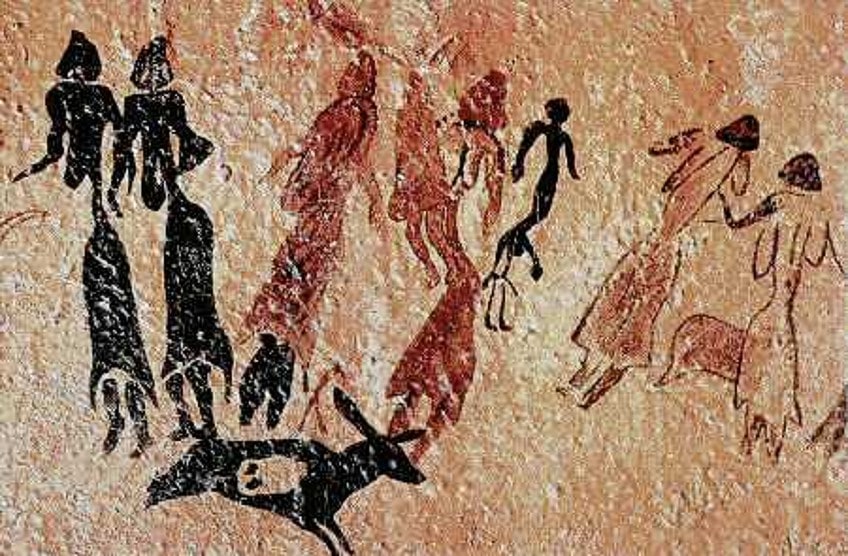
The figures depicted in this era are more energetic in their poses and smaller than their Paleolithic counterparts. Small, simply engraved pendants have also been discovered from this period. In the Neolithic Period, many Central European cultures tended to produce mostly female statues and very few examples of male figurines, as well as animal figures and detailed pieces of pottery.
Many megalithic monuments were built in this era such as Stonehenge and the Temples of Malta, some of which have spirals and other patterns carved into the huge stone structures such as the tomb in Ireland which is said to have been dated from somewhere around 32000 BC.
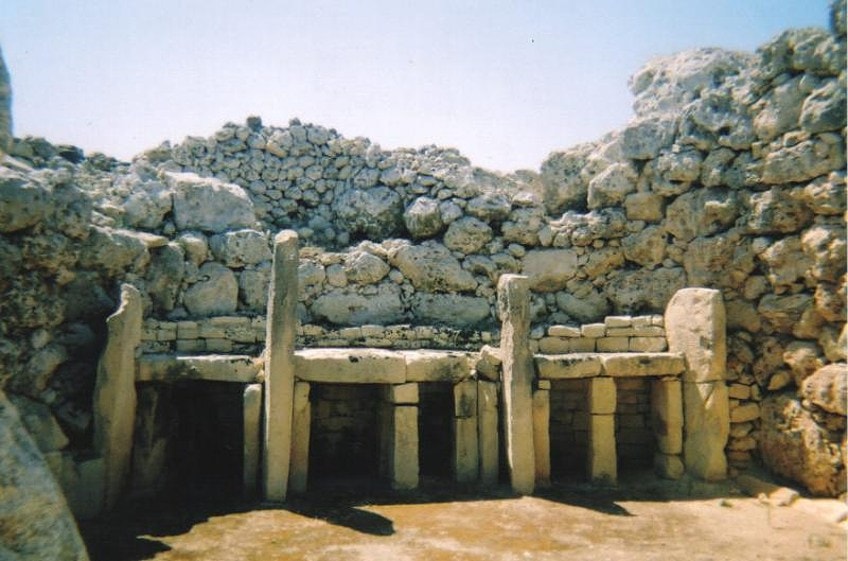
The Bronze Age in Europe saw the rise of new techniques in tool development and this had a great impact on the quality and speed in which artisans could create works of art.
It is due to the rising productivity that society in general began to experience a surplus of luxury items such as weapons that had been artfully decorated.
During this period we see many fine examples of decorated weapons such as ornamental swords and ax handles, as well as ceremonial helmets made of bronze. During the following Iron Age, the focus would shift to anthropomorphic sculptures, which attributed human characteristics to various animals and objects.
African Prehistoric Art
The first known prehistoric drawing created by Homo Erectus was found by archeologists in Southern Africa in September 2018. The prehistoric drawing is estimated to be approximately 73, 000 years old, which is considerably older than what was previously discovered by about 43, 000 years. Some rock paintings made by the San people in the Drakensberg area are thought to be from the period 8000 BCE.
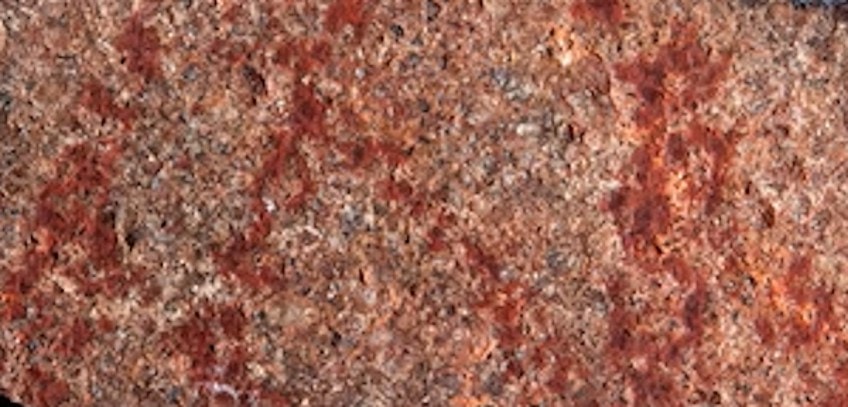
These paintings have remained remarkably clear and portray a multitude of human figures and animal motifs, most notably antelope. However, not all rock art in the area is thought to be ancient in origin, with a fairly unbroken tradition of painting that has continued until as recently as the 19th century, with horses displayed in some paintings, which there were none of in the local environment until introduced there by foreigners in the 1820s.
Rock art depicting pastoral scenery can be found at Laas Geel in northwestern Somalia. This formation of caves contains some of the earliest examples of cave paintings and prehistoric drawings in the region known as the Horn of Africa. They are estimated to have been made sometime between 9000 and 3000 BCE. In 2008, the earliest portrayal of a hunter riding a horse was discovered by archeologists.
It has been dated in the ballpark region of 1000 to 3000 BCE and was created in the typical Arabian/Ethiopian style.
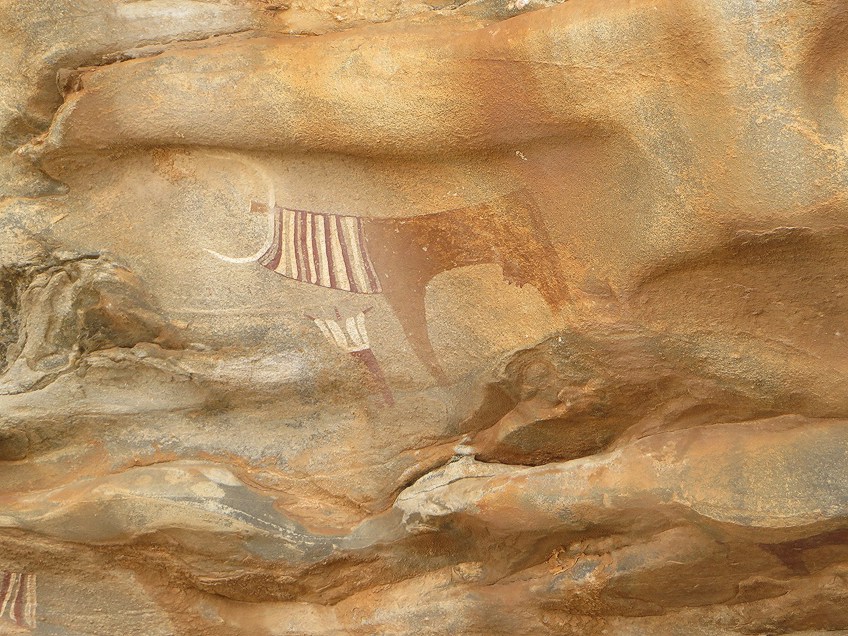
Saharan Africa had its unique style and techniques, with depictions of fauna carved onto walls. Weirdly formed human figures were prominent throughout this period as well as a few animal depictions. As lifestyles changed for the people towards the end of this period, focus on the subject turned towards the depiction of domesticated animals, as well as decorative headdresses and ornate clothing.
During this time, figures became simplified in design and focussed on common domestic everyday scenes such as the herding of animals and dancing.
Prehistoric Art of the Americas
The Vero Beach Bome is the oldest known piece of art in the Americas and belongs to the Lithic Period. Dating back to approximately 11, 000 BCE, it is thought to be made of mammoth bone and has been etched with the image of a walking mammoth. In Mesoamerica, we find the Olmec Bird Vessel and Bowl, dated from around 1000 BC and both made from ceramic.
This is noteworthy for its time, as kilns had to reach temperatures above 900 degrees celsius for the ceramics to be produced, and outside of Egypt, they were the only known culture that was able to do so at this time.
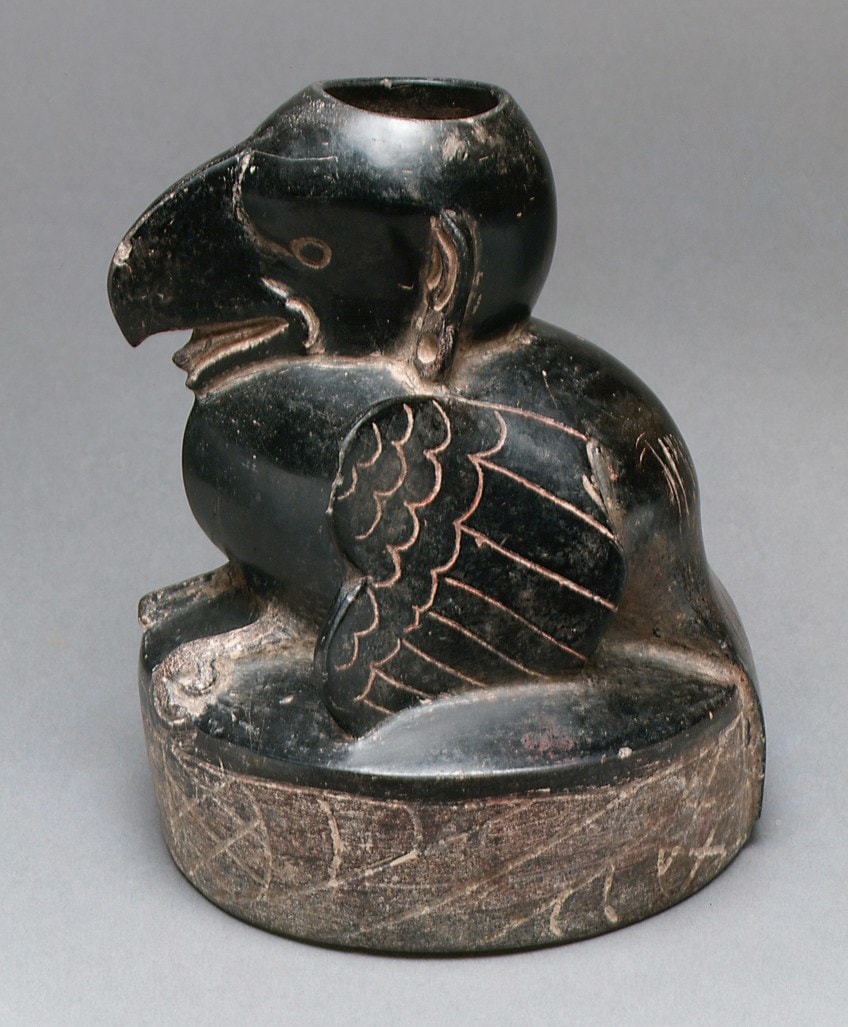
Olmec art can easily be recognized by the use of reflective iconography within a religious context as well as being highly stylized. However, despite being stylized, there are also examples of more naturalistic Olmec art depicting the human form. Large monumental figurines are abundant in this era as well as small carved figures made of jade.
Peru in South America has a long recorded history of human culture dating as far back as 10, 000 BCE. Rock paintings in the Toquepala Caves have been dated as far back as 9500 BCE. Beads have been found at ceremonial burial sites that are dated to be from somewhere between 8600 and 7200 BCE. Ceramics have been found that date from around 1850 BCE.
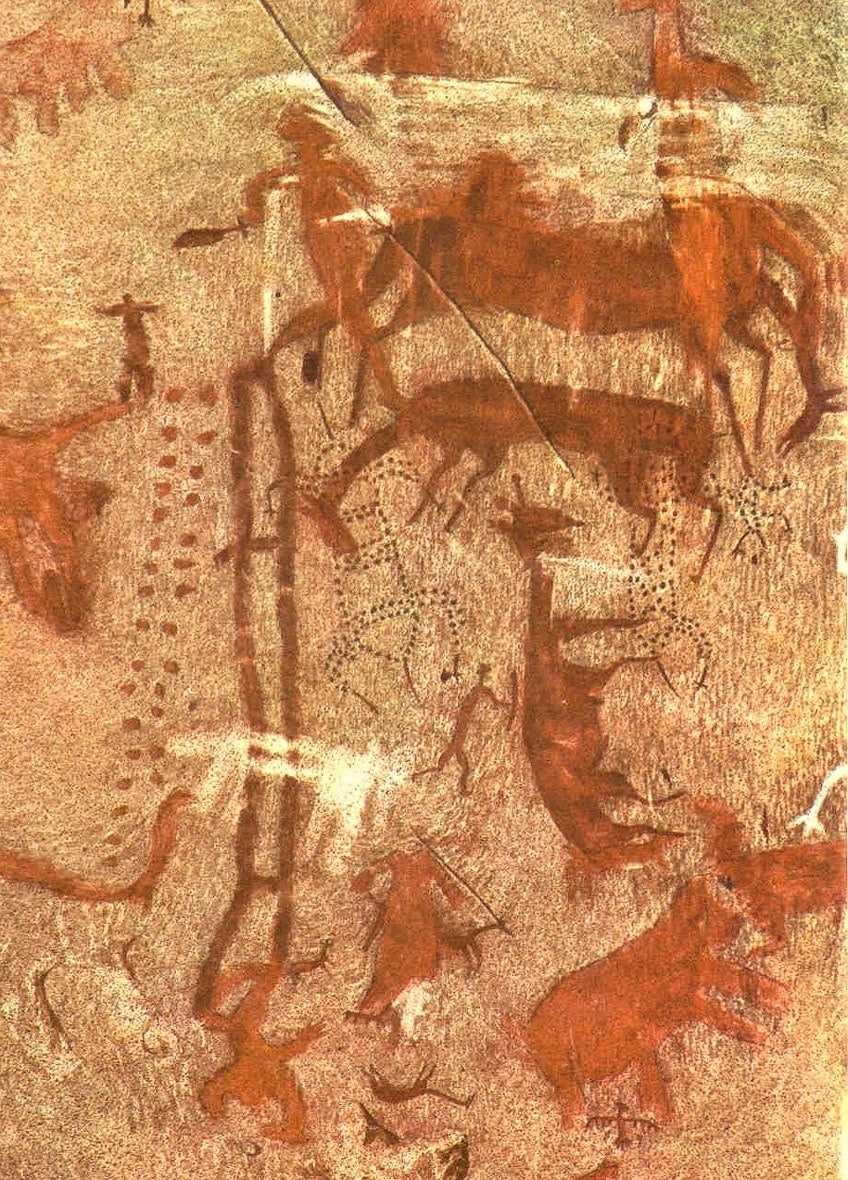
The Initial Period for cultures in the Central Andean region lasted approximately somewhere from 1800 BCE to 900 BCE. Textiles from this period display an incredible complexity and included images such as birds with two heads and crabs with snakes for claws. Depending on how it is viewed, various subjects can seem to dominate the work in some kind of optically created illusion. Artwork that was considered portable at the time included jewelry made of shells and bones, clay female figures, and mirrors that were highly decorated.
The early Intermediate period is epitomized by work that was extremely demanding of its artist in both time and level of detail required for each piece and used an abundance of visual elements in a vividly colorful manner.
Famous Examples of Prehistoric Art
It is hard enough to ask the question “what is prehistoric art” without even considering the question ”who created the art, what was the name of the prehistoric artist?” These pieces of prehistoric art history were created before written languages had been developed yet, so the chances of us discovering a signature or name seem rather slim to none.
Yet, we have managed to learn much about the people who created these artworks as well the techniques they used, and what daily life was like for people in the very distant past.
Blombos Cave
Blombos Cave is situated 300kms from Cape Town in the Blombos Private Nature Reserve and is considered an extremely important archeological site. It is here that archaeologists found what is now thought to be the oldest known drawing created by human hands, and is estimated to be about 73, 000 years old based on surrounding deposits.
Very little is known about humans from this period, so it comes as a surprise to researchers that humans from this time would display an ability to create works of art.
Researchers hope the find will assist them in gaining insight into our species’ first attempts at the use of symbols – a technique of communication and representation that would pave the way for mathematics and the formation of spoken and written languages.

One artifact from this location is a tiny piece of ochre stone, measuring a diameter comparable to the length of a couple of thumbnails. The flake of stone has six distinct lines drawn on it as well as three curved diagonal lines running across it. The lines end suddenly, hinting at the possibility that the pattern extended further beyond the edges of what remains of the flake, in a far more complex manner than initially available to see from the flake he found.
There has been much debate on his assertions that it was made by Homo Sapiens and intentionally created, and several attempts were made at replicating the potential techniques used by a group of French experts. They analyzed the chemical composition of the pigments, and after replicating various techniques, it was concluded that the most likely substance used to create the lines was ochre.
Venus of Willendorf
The Venus of Willendorf was discovered in 1908 at the site of Willendorf in Austria by digger Johann Veran during excavations. It has been carved out of oolitic limestone not found in its native region and slightly tinted in pigment made of red ochre. Based on it being made from non-native stone, this sculpture is thought to have been produced somewhere else and then transported to where it was later found.
Some believe it was created as some kind of goddess symbol of fertility, a charm that brings one good luck, or even possibly a talisman designed as an aphrodisiac.

The figure consists mostly of a female torso and breasts, with the arms present, but not anatomically represented, they seem understated and shrunk. There is a head visible, but one that does not show any features except a stylized pattern perhaps meant to represent braided hair or some kind of head cap.
The feet also seem to be missing or were perhaps not ever part of the initial design, to begin with. It is believed to be a fertility statue as the body parts associated with reproduction seem to be disproportionately exaggerated.
This is one of many sculptures from the Paleolithic Period that have been titled “Venus” sculptures even though they greatly outdated the culture and theology behind the Venus from mythology known by traditional scholars.
There has been some speculation that perhaps the carvings were created by women themselves as a means of self-representation. This was in a time when there were no reflective surfaces such as mirrors and the proportions of the figurines seem to match up with the associated angle a woman would see of her own body if looking down at it.
Lubang Jeriji Saléh
Borneo island is home to a limestone complex of caves known as the Lubang Jeriji Saléh. At around 40, 000 years old, it is thought to be one of the oldest figurative paintings known to the world. Located in the East Kalimantan mountains, this series of caves are covered in images of hands that have been made visible through applying flashes of bright orange ochre and iron oxide paint to the walls, spraying the colors over the hand, and leaving an outline of it amongst the burst of colors on cave walls.
These hand outlines have been dated to have been created around 52, 000 years ago. It is amongst these paintings that we also find the bull, thought to be the first figurative painting created by human hands approximately 40, 000 years ago. The illustrated bovine stretches over a rocky canvas measuring more than five feet in length and has been applied to the limestone walls using red ochre paint.
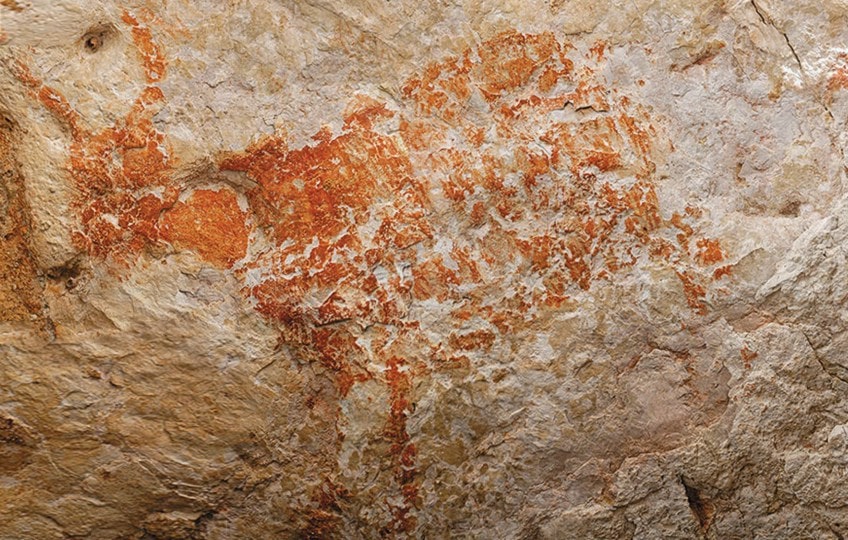
In 2018, scientists were able to do a more in-depth analysis of samples taken from the site and concluded that the site was decorated in three stages over time. During the first stage, the hands and bull were added. In the second stage, complex motifs were added, using stencils and a mulberry-colored paint mix. During the third and final phase, water vessels, designs of geometric patterns, and human-like figures were added to the cave walls.
The team that led the research of the site in 2018 originally concluded that this was the first known example of a figurative painting by a prehistoric artist.
However, they have since made further discoveries of artworks in caves in Sulawesi that are even older at around 44, 000 years of age. This discovery still holds much significance for art historians, however, as it shows us that cave art gave rise at the same time in Asia as it did in Europe. Experts agree that the finding is very significant to archeological discovery, yet has little to offer in terms of data on the early origins of art geographically speaking.
Lascaux Cave Paintings
The Vézère Valley is home to many famously decorated caves that were first discovered in the early days of the 20th century. Amongst them, one of the most well-known would be the Lascaux cave paintings. Renowned for its Paleolithic era cave paintings, the caves are situated in Dordogne, a region of southwestern France. They are most highly revered for the complexity of design, outstanding quality of production, age, and sheer scale. The paintings are estimated to be in the region of 20, 000 years of age.
A cave complex consisting of several areas, Lascaux was discovered on 12 September 1940 and later that year was honored with historic monument protection status.
Lascaux caves are part of several cave complexes in the area that were added to the UNESCO list of World Heritage Sites, yet they remain in constant danger of further deterioration and are the constant source of symposiums for archeologists and scientists to discuss how to handle these artworks to ensure a legacy that spans even further into the future.
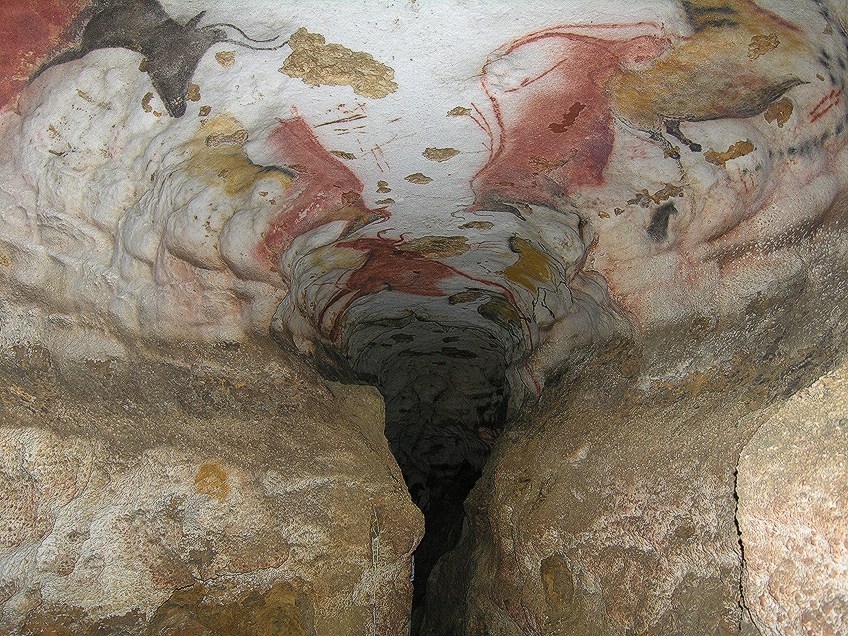
Archeologists have identified several distinct sections of the cave complex, giving them such titles as The Great Hall of the Bulls, The Chamber of Felines, and The Shaft of the Dead Man. Abstract symbols, animal effigies, and human figures form the three groups that the more than 2000 figures on the cave walls can be divided into.
The majority of these images have been impressed on the wall with painted mineral pigments, although others have been chiseled into the stone’s facade.
The paintings in Lascaux caves mainly consist of 364 horse figures, as well as ninety stags and various other animals such as felines, rhinos, cows, a single bear, bison, and even a human. In the Hall of Bulls, we find the most well-known image of the cave, the four black bulls, one of which alone is 17 feet in diameter, which makes it the largest known painting of an animal in cave art.
The Chauvet-Pont-d’Arc Cave
Archeologists have concluded that the figurative cave paintings in the Chauvet Cave are some of the most well-preserved examples of prehistory art around the globe. The cave is situated on a cliff made from limestone in Ardeche, Southeast France, and was first discovered on 18th December 1994.
It is considered by many art historians and archeologists to be an extremely important prehistoric site, with UNESCO granting the cave’s World Heritage status in 2014.
Various groups of researchers have gathered significant data and understanding of the culture that may have created it over the years. Not only were paintings discovered by archeologists, but also the fossil remnants and markings of animals, many of which no longer exist today.
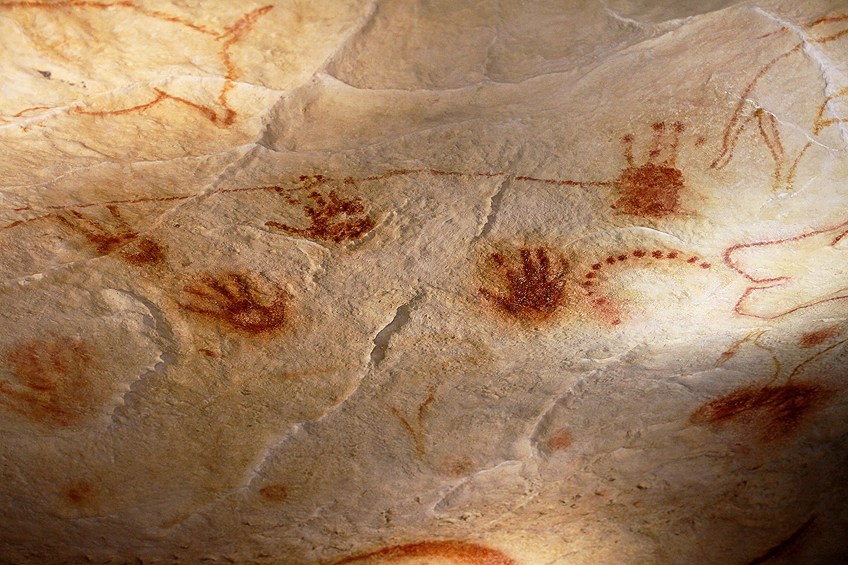
Recent carbon dating studies have isolated two periods in which the caves were habituated by humans, a period from 37, 000 to 33, 500 years ago and another period following that from 31,000 to around 28,000 years ago.
All that remains from the latter period are the prints of a child’s foot, the sooty remnants of the community fireplace, and blackened stains on the cave walls from the use of torches.
The child’s footprints could be the oldest prints of the human foot that can accurately be dated, as, after the visitation of the child who made the prints, the cave remained untouched until its rediscovery in 1994 due to a landslide or something similar.
Göbekli Tepe
Göbekli Tepe is situated in Southeastern Anatolia in Turkey and is considered by historians to be a site of significance for human civilization and the development of culture and art. The Mesolithic age mound is a prime example of megalithic art. Göbekli Tepe was formed by one settlement built upon another settlement in the same place over time, the debris and remnants from the former settlements stacking up over the decades to create a mound that exceeds fifteen meters in height and around 300 meters in diameter.
The multi-layered complex has been carbon-dated to around 9559 BCE and it is said to contain the oldest stone structures bearing artwork engraved upon it.

The most common motifs were the depiction of various animals such as boars, bulls, foxes, and lions. Only a few examples of imagery depicting the human figure have been found at this particular site, a notable exception being the relief of a naked female crouching down on the ground. The true purpose of this site remains shrouded in mystery, but the archeologist Klaus Schmidt has suggested that the site was most likely used as a cult center or holy place during the Neolithic period. This is largely evident by the unusual number of megaliths that were used in the construction of the layout of the site.
In summary, we have learned that prehistoric art predates the use of written language by various cultures throughout human history. We have also seen how the period of transformation for each culture to one based on written text differs from region to region. There are examples of early cave art that appear simultaneously in both Asia and Europe.
Frequently Asked Questions
What Is Prehistoric Art?
Prehistoric art refers to all art that was created before cultures had developed more complex forms of expression and communication such as a written language. Prehistoric art can not only be described as art found on cave walls, but also prehistoric sculpture such as the Venus figurines. Some of the earliest examples of prehistoric art in civilized communities are the huge monoliths found in ancient sites such as Gobekli Tepe and many others.
What Techniques and Methods Were Used in Early Prehistory Art?
As with any era, artists that created prehistory art were limited by the resources available to them at the time they lived. The very first art was made from tools and canvases readily accessible to them such as cave walls, bones, and pigments such as ochre and burnt wood. Not only did they use various pigments to paint on surfaces, but also carved images on bone, stone, and walls, as well as made various pieces of clay sculpture and pottery from available materials in the region.
Isabella studied at the University of Cape Town in South Africa and graduated with a Bachelor of Arts majoring in English Literature & Language and Psychology. Throughout her undergraduate years, she took Art History as an additional subject and absolutely loved it. Building on from her art history knowledge that began in high school, art has always been a particular area of fascination for her. From learning about artworks previously unknown to her, or sharpening her existing understanding of specific works, the ability to continue learning within this interesting sphere excites her greatly.
Her focal points of interest in art history encompass profiling specific artists and art movements, as it is these areas where she is able to really dig deep into the rich narrative of the art world. Additionally, she particularly enjoys exploring the different artistic styles of the 20th century, as well as the important impact that female artists have had on the development of art history.
Learn more about Isabella Meyer and the Art in Context Team.
Cite this Article
Isabella, Meyer, “Prehistoric Art – History of Humanity’s Earliest Artforms.” Art in Context. November 19, 2021. URL: https://artincontext.org/prehistoric-art/
Meyer, I. (2021, 19 November). Prehistoric Art – History of Humanity’s Earliest Artforms. Art in Context. https://artincontext.org/prehistoric-art/
Meyer, Isabella. “Prehistoric Art – History of Humanity’s Earliest Artforms.” Art in Context, November 19, 2021. https://artincontext.org/prehistoric-art/.








